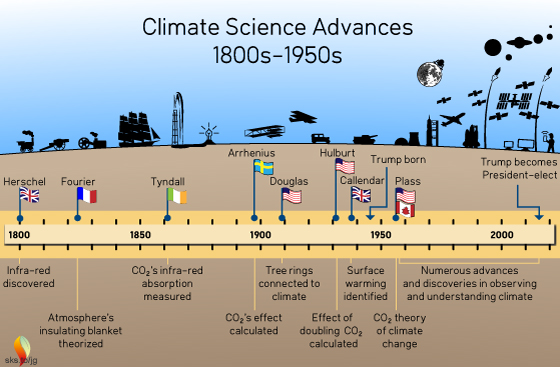
Dear Mr President-elect,
On 6 Nov 2012, at 11:15 am, you tweeted:
“The concept of global warming was created by and for the Chinese in order to make U.S. manufacturing non-competitive.”
We'd like to take you on a quick tour back through the ages, because the early understanding of Earth's climate - and the role that carbon has to play in it - came from the West, not the East. Let's run through it quickly.
In 1800, British astronomer William Herschel first measured the heat that occurs in the warm – now known as infra-red (IR) – part of the spectrum. In 1824, French engineer Jean Baptiste Joseph Fourier calculated that Earth should be colder than it is, at its orbital distance from the Sun. Today, it is common knowledge that outgoing IR radiation is emitted by the Earth's surface in response to heating by the Sun. But Fourier was the first to figure out that the IR was being slowed down during its journey back out to space. The air, he said, must act as a form of insulating blanket, keeping the planet warm. Smart guy.
This was just two years before Samuel Morey patented the first internal combustion engine.
In 1861, Anglo-Irish physicist John Tyndall observed that some atmospheric gases were transparent to IR radiation. But he found that others, like water vapor and carbon dioxide, were powerful IR absorbers. He was the first to propose that changes in the amount of carbon dioxide in the atmosphere could influence the Earth's climate. In 1896, Swedish scientist Svante Arrhenius took it further. He made the first detailed calculations to see what a doubling of carbon dioxide levels might do to temperatures. His answer was a 5-6°C increase in the average global temperature. His ‘hot-house theory’ was set out for the first time in 1908 in his popular book ‘Worlds in the Making’.
In 1909, American astronomer Andrew Douglass developed the techniques of studying tree-rings and was the first to find the connection between tree ring widths and climate. In 1931, American physicist E.O Hulburt ran calculations to determine the effect of doubling carbon dioxide with the added burden of water vapor. His figure? 4°C of warming. In 1938, English engineer Guy Callendar discovered evidence of a warming temperature trend in the early twentieth century. He also found that CO2 levels were increasing and he warned that over the coming centuries there could be a climate shift to a permanently warmer state.
Mr President-elect, you were born in June 1946, in the early years of the Cold War. It was a time that saw a surge in atmospheric research. The properties and behaviour of IR radiation came under even more scrutiny in the quest to develop heat-seeking missiles. By the 1950s, the advantage of computer-power, something we take for granted today, made it possible to dissect the atmosphere in ever-greater detail. 1956 - when you were just ten years of age - saw the publication of the landmark paper, 'The Carbon Dioxide Theory of Climatic Change', by Canadian-American physicist Gilbert Plass. The paper confirmed that more carbon dioxide would have a warming effect and that doubling levels of that gas would result in a warming of 3-4°C. The very title of the paper tells you that "climate change" is not a term made up in recent years for political reasons, as some try to claim.
Mr President-elect, we've known about this stuff for decades. None of the above is "politicized science". Even the youngest milestones along the climate science timeline above are now more than half a century old. Most of them are older than you. They were all attained through the hard work and dedication of our best American and European scientists. These guys and others laid the solid and vital foundations for the modern understanding of how Earth's climate works. They got all the basics right: it is organisations like NASA that are still filling in the important details. The more we end up knowing about how this planet works the better, especially if the USA plans to continue its exploration missions to other planetary bodies.
Atmospheric CO2 levels have now gone past 400 parts per million. That's up 40% from the pre-industrial level of 280ppm - thanks in great part to the burning of the fossil fuels. Now, as a businessman, you can understand numbers. Some folk like to downplay the importance of gases occurring at, they say, small concentrations. But we think that if we knocked on your office door with details of a whole mountain containing an average of 400ppm gold, you'd sit down and listen.
We cannot look anywhere within the geologically recent series of alternating ice-ages and interglacials to see an Earth with more than 400ppm carbon dioxide in its atmosphere. We have to go back a lot further. To see a 400ppm-plus planet, we need to time-travel to the mid-Pliocene, 3.5 million years ago. Back then, Arctic Siberia, today a barren tundra, was shrouded in boreal forest. That might sound OK, but such warmth has its price. Due to less ice at the poles, it was also a time when sea-levels were around twenty metres higher than those of today. That's not good if you have beach-front real estate. Such changes can take many years to bring about, but Earth's physical systems always move towards balance. Earth systems obey the laws of physics, not economics. They take no notice at all of electoral cycles or partisan politics. They don't care which guy you voted for.
Mr President-elect, we have to work with the Earth, not against it.
For a full account of the history of climate science, please follow the link below.
The History of Climate Science

Posted by John Mason on Tuesday, 29 November, 2016
 |
The Skeptical Science website by Skeptical Science is licensed under a Creative Commons Attribution 3.0 Unported License. |